A traditional shogayaki ginger pork recipe you can make in 20 mins
Shogayaki is one of the most popular pork recipes in Japan, right up there with Tonkatsu (or deep-fried pork).
Shogayaki is a dish with a thinly sliced pork loin from the shoulder or belly, seasoned with soy sauce, mirin, sake, ginger, onion, and garlic cooked in a pan in less than fifteen minutes.
It’s one of those recipes you can throw together in minutes and then enjoy alongside a crispy cabbage salad or rice.
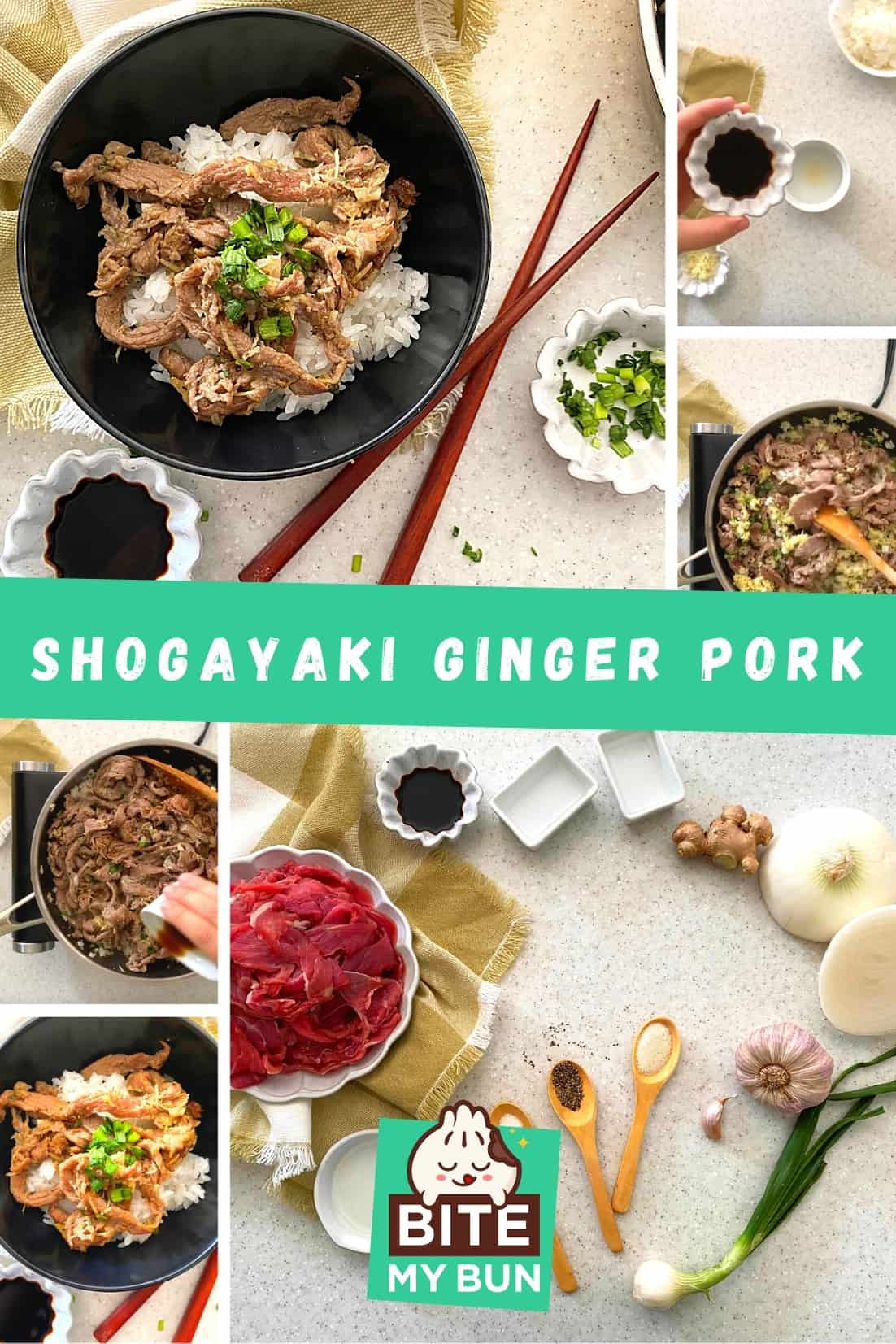

Check out our new cookbook
Bitemybun's family recipes with complete meal planner and recipe guide.
Try it out for free with Kindle Unlimited:
Read for freeIn this post we'll cover:
- 1 How to make Shogayaki
- 2 20 min Shogayaki ginger pork recipe
- 3 Preparing the pork for shogayaki
- 4 How to serve shogayaki & common side dishes
- 5 Can you store shogayaki in the fridge and freezer?
- 6 Variations on shogayaki
- 7 Shogayaki: nutritional information
- 8 What is shogayaki ginger pork?
- 9 Origin of shogayaki ginger pork
- 10 Conclusion
How to make Shogayaki
It’s an easy recipe with a handful of ingredients, but the taste is definitely more delicious than the average pork recipe. So let’s get to making it!
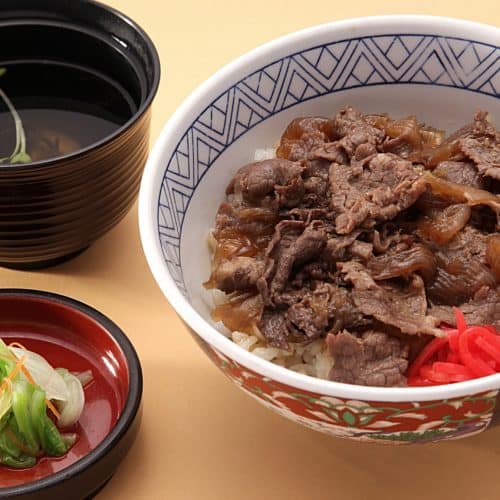
20 min Shogayaki ginger pork recipe
Ingredients
- ½ lb pork loin, belly, or shoulder thinly sliced
- ½ onion
- 1 clove garlic
- 1 inch ginger grated
- 1 tbsp vegetable oil
- 1 green onion or scallion chopped
For the sauce:
- 2 tbsp soy sauce
- 2 tbsp mirin
- 1 tbsp sake
- 1 tsp sugar
- 1 pinch salt
- 1 pinch pepper
Instructions
- Gather all of the ingredients and in a small bowl, grate the ginger, garlic, and chop the onion and green onion or scallion. You can also mince the garlic and ginger or use a garlic press.
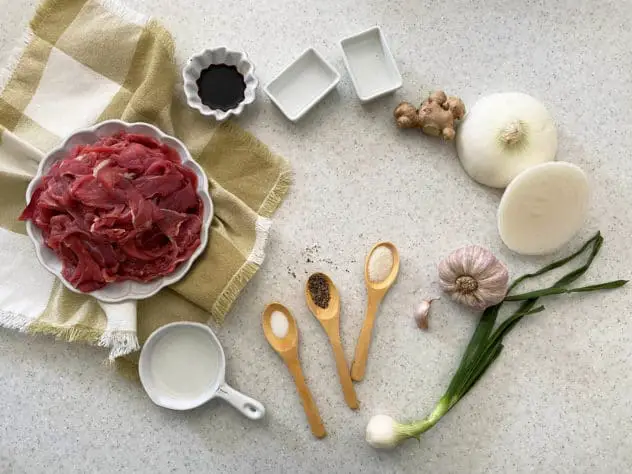
- Add the soy sauce, mirin, sake, and sugar to the bowl and mix.
- Season the meat with salt and pepper.
- Grab a large non-stick pan and heat up the oil on medium-high heat.
- Add the onions and meat to the pan.
- Cook the meat for about 4 minutes on each side. Make sure to stir the onions too.
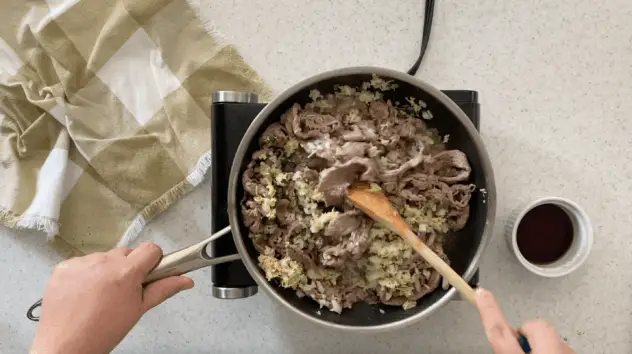
- Once the meat is brown, add the ingredients you mixed earlier.
- Let it bubble away for a minute or two until the meat starts to caramelize. You can add a little extra soy sauce if all of the liquid has evaporated.

- Garnish with scallion and serve.
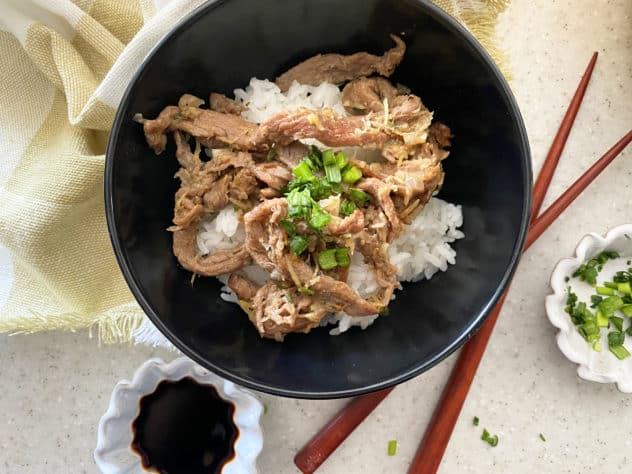
Video
Nutrition
As soon as you start frying the pork in the pan, you’ll smell the aromas of the ginger and sake, and it’s so good, you’ll probably want to make this meal over and over again.
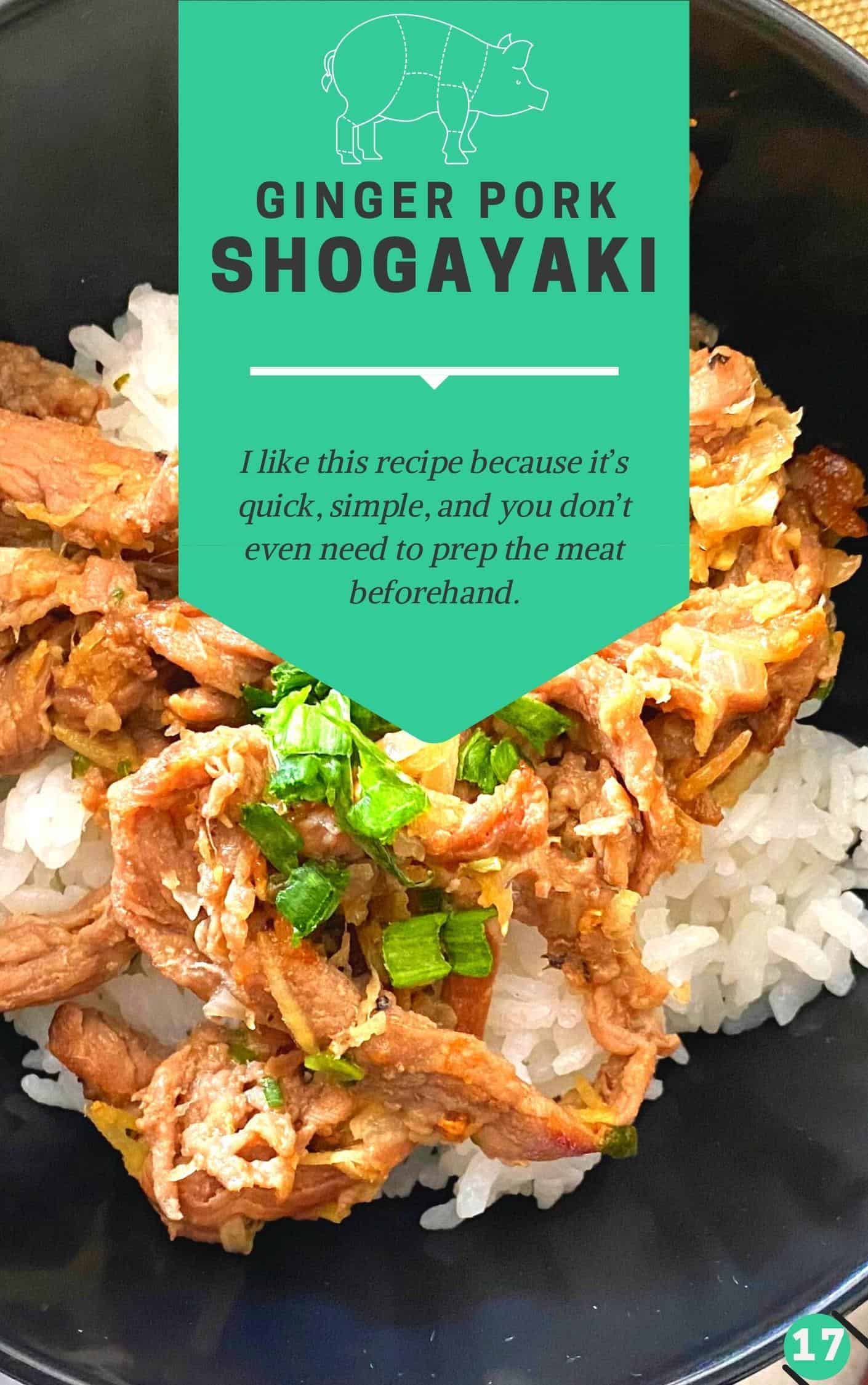
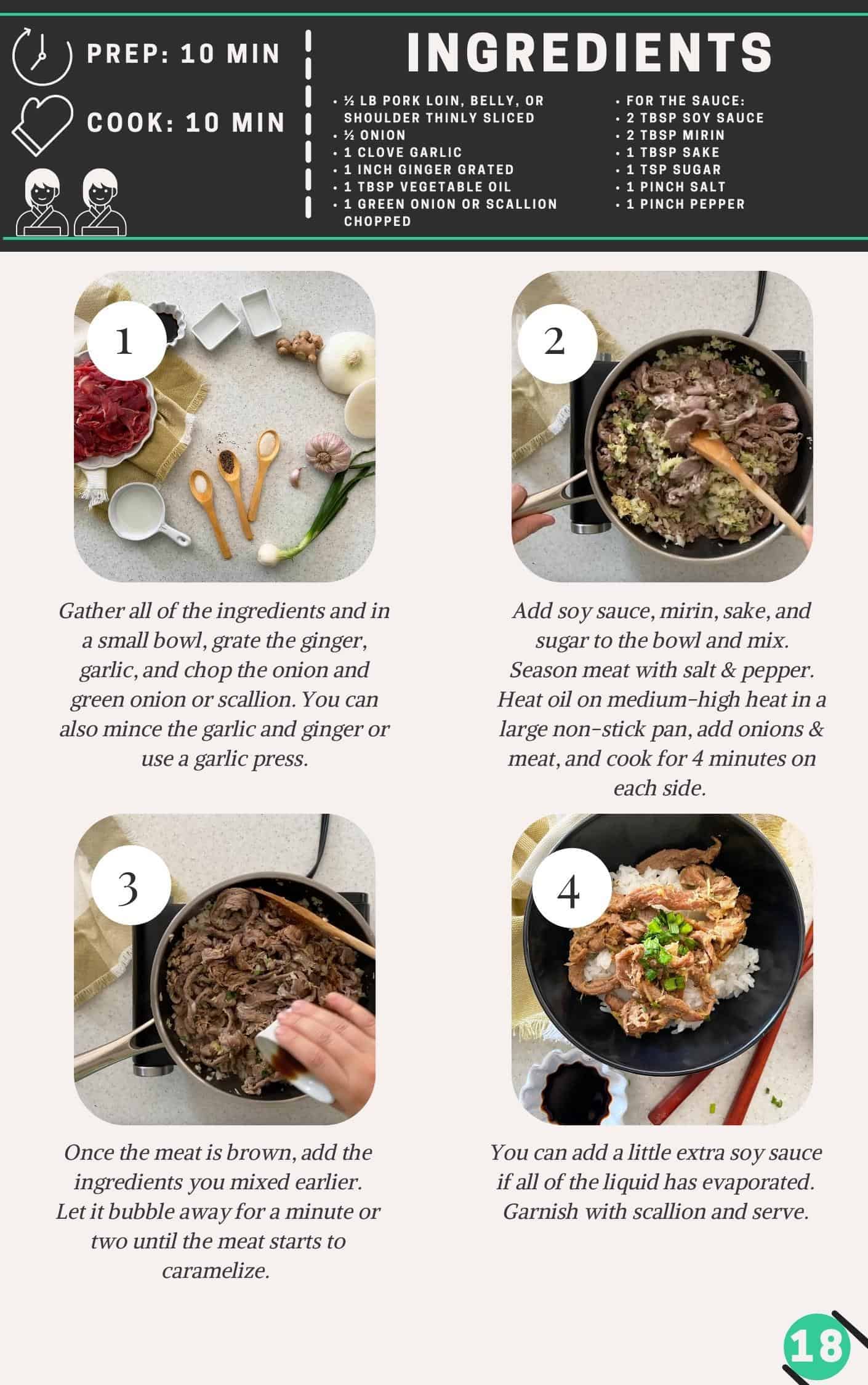
Preparing the pork for shogayaki
Most Asian grocery stores sell thinly sliced pork for these types of recipes.
But, if you can’t find it in your area, check out this video to learn how to slice paper-thin meat pieces:
How to serve shogayaki & common side dishes
Thinly shredded cabbage is the most common side dish for ginger pork. No seasoning is added, and usually, the cabbage is eaten raw.
If you want some flavor for the cabbage, though, add a miso ginger dressing.
The second most common side dish is fluffy white steamed rice.
Still looking for a good rice cooker? Find the best rice cookers reviewed here
But, you can also have a vegetable salad as the pork is flavorful enough on its own, so you can just add a very light side dish.
To serve, simply plate it with the rice and your side dish and serve it while hot.
Shogayaki-donburi
Shogayaki-donburi refers to shogayaki served in a rice bowl. It’s the same thing as ginger pork served with some rice on the same plate, but it’s served in a bowl.
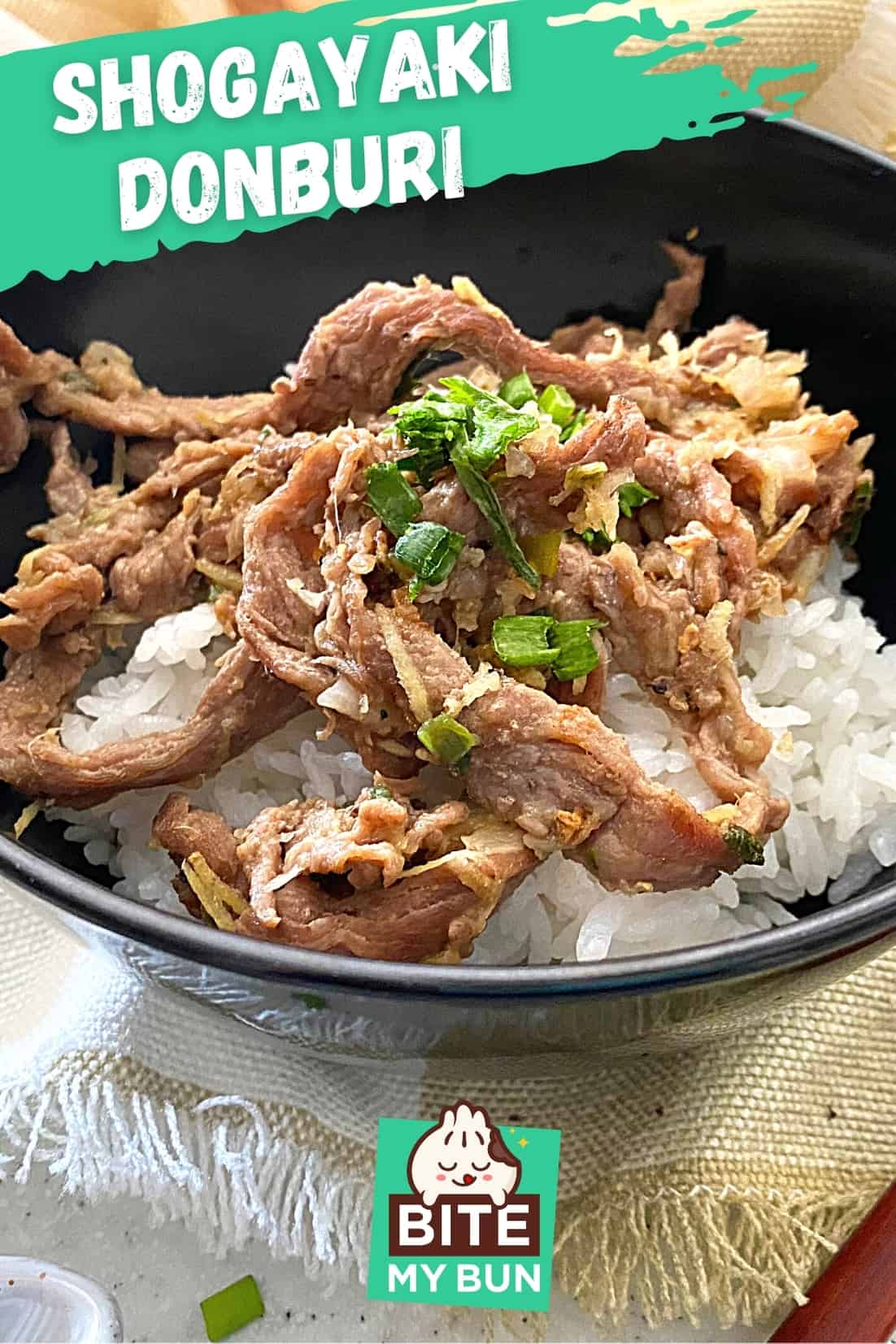
You can mix the rice with the pork, so the rice absorbs the flavors of the sauce.
Related: 15 Authentic Donburi Bowls reviewed and how to use them
To make this a complete meal, you can serve hot miso soup first, and then the Shogayaki with rice and/or cabbage.
Can you store shogayaki in the fridge and freezer?
You can store the pork in the fridge for up to 3 days in an airtight container or place it in the freezer for one month at most.
Variations on shogayaki
There are several variations of this dish and some great alternative ingredients.
You can skip the onion and garlic and use only ginger as the main flavoring ingredient.
In some areas of Japan, people skip the mirin and only use soy sauce and sake (or cooking sake).
Many people like to marinate the meat beforehand for about 30 minutes and then add the marinade’s leftover juice to the pan as it cooks.
The best cut for this recipe is pork shoulder or loin, but the fatty belly is good as well.
The cuts of meat don’t have to be expensive, and since you’re cutting them paper-thin, it doesn’t matter if there’s a little bit more fat on them.
When using tenderloin, there’s no need to marinate the meat at all because the ginger softens it.
If you want the sauce to stick to the meat better, you can add a light dusting of flour or potato starch. It will make it similar to “sticky pork.”
You can use miso paste in your sauce instead of soy sauce for a deeper fermented food flavor. This is not a very common substitute, but it brings the flavor up a notch and gives the meat a nutty and earthy taste.
Also read: Can Miso Expire? Storage tips & how to tell when it goes bad
Shogayaki: nutritional information
1 serving of shogayaki pork has approximately:
- 400 calories
- 26 g fat
- 10 g carbs
- 28 g protein
- 450 mg sodium
It is a high source of fat, sodium (salt), and cholesterol. Depending on your side dish, you can add an extra 100-300 calories to your serving.
The healthy part of this dish is that it has beneficial vitamins and minerals, including iron (8%), calcium (3%), vitamin C (2%).
One of the main benefits of this dish is ginger. It is considered a “superfood” because it contains antimicrobial compounds which destroy pathogens.
Ginger is very healthy for the body and helps you treat inflammation as well as heal from infections.
In this recipe, ginger helps break down the pork’s connective tissues. It contains an enzyme called zingibain, which makes the meat more tender and juicy.
What is shogayaki ginger pork?
Technically, shoga is the Japanese word for ginger, and yaki means grilled or sauteed. So you can grill any type of meat this way and it’ll still be called shogayaki.
The full name of this dish is Buta no Shogayaki (豚の生姜焼き), because buta means pork.
It’s a lunchbox essential in Japan and one of the top lunch or dinner recipes, and that’s because it’s quick and simple to make, and you can use cheaper cuts of meat.
Usually, shogayaki is made with paper-thin sliced pork loin, belly, or shoulder. But, some people prefer to use chicken or beef, although it’s not nearly as popular as pork, which pairs the best with ginger.
Thus, this ginger pork is all about bringing together the flavor of onion, ginger, garlic, and the fermented rice-based alcohol of sake, and mirin.
Soy sauce is also added to bring in some savory saltiness.
The thinner the pork slices, the better because the sauce can enter the meat and infuse it with all that delicious flavor.
Origin of shogayaki ginger pork
This dish originated sometime in the early 20th century in Tokyo, Japan.
Initially, this dish was only common in the Tokyo region, but it spread to the Kanto region and soon became a beloved food all over the country.
Chefs decided to add ginger to mask the strong odor of pork meat. As you cook with pork, it can give off a strong smell, and ginger makes it smell better.
So it was specifically designed to be used with cheaper cuts of meat.
The dish was most popular as a home-cooked meal for lunch and dinner, but it made its way into restaurant menus in the 1920s, and people really loved it.
Since then, the recipe has remained mostly unchanged, and people still love it!
Conclusion
Next time you’re craving a meaty and slightly spicy Japanese meal, try this simple and quick staple pork recipe.
The ginger and garlic combo will leave your mouth watering. The meat is so tender and flavorful, a simple cabbage salad is all you need to pair with it.
Once you’ve tasted the pork version, you can always try a variation with beef or chicken.
And if you like meat dishes and have a little more time, you should check out this great Japanese beef curry as well
Check out our new cookbook
Bitemybun's family recipes with complete meal planner and recipe guide.
Try it out for free with Kindle Unlimited:
Read for freeJoost Nusselder, the founder of Bite My Bun is a content marketer, dad and loves trying out new food with Japanese food at the heart of his passion, and together with his team he's been creating in-depth blog articles since 2016 to help loyal readers with recipes and cooking tips.
